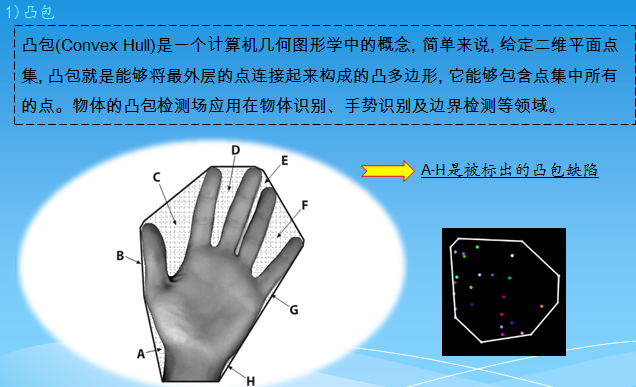一、简介



二、绘制点集的凸包
1 #include<opencv2/opencv.hpp>
2 using namespace cv;
3
4 void main()
5 {
6 //---绘制点集的凸包
7 Mat img(400, 400, CV_8UC3, Scalar::all(0)); //定义绘制图像
8 RNG rng; //定义随机数对象
9 while(1)
10 {
11 char key;
12 int count = (unsigned int)rng % 100; //定义点的个数
13 vector<Point> points; //定义点集
14 for(int i=0; i<count; i++)
15 {
16 Point pt;
17 pt.x = rng.uniform(img.cols/4, img.cols*3/4); //设定点的x范围
18 pt.y = rng.uniform(img.rows/4, img.rows*3/4); //设定点的y范围
19 points.push_back(pt);
20 }
21
22 //检测凸包
23 vector<int> hull;
24 convexHull(Mat(points), hull, true);
25
26 img = Scalar::all(0);
27 for(int i = 0; i < count; i++ )
28 circle(img, points[i], 3, Scalar(rng.uniform(0, 255), rng.uniform(0, 255), rng.uniform(0, 255)), CV_FILLED, CV_AA);
29
30 //准备参数
31 int hullcount = (int)hull.size(); //凸包的边数
32 Point point0 = points[hull[hullcount-1]]; //连接凸包边的坐标点
33
34 //绘制凸包的边
35 for(int i = 0; i < hullcount; i++ )
36 {
37 Point point = points[hull[i]];
38 circle(img, point, 8, Scalar(0, 255, 0), 2, 8);
39 line(img, point0, point, Scalar(255, 255, 255), 2, CV_AA);
40 point0 = point;
41 }
42
43 //显示效果图
44 imshow("img", img);
45
46 //按下ESC,Q,或者q,程序退出
47 key = (char)waitKey();
48 if( key == 27 || key == 'q' || key == 'Q' )
49 break;
50 }
51}

三、绘制轮廓的凸包
1 #include<opencv2/opencv.hpp>
2 using namespace cv;
3
4 void main()
5 {
6 Mat srcImg = imread("E://12.jpg");
7 imshow("src", srcImg);
8 Mat dstImg2 = srcImg.clone();
9 Mat tempImg(srcImg.rows, srcImg.cols, CV_8UC3, Scalar::all(0)); //用于绘制凸包
10 Mat dstImg(srcImg.rows, srcImg.cols, CV_8UC3, Scalar::all(0)); //用于绘制轮廓
11 cvtColor(srcImg, srcImg, CV_BGR2GRAY);
12 threshold(srcImg, srcImg, 100, 255, CV_THRESH_BINARY); //二值化
13
14 vector<vector<Point>> contours;
15 vector<Vec4i> hierarcy;
16 findContours(srcImg, contours, hierarcy, CV_RETR_EXTERNAL, CV_CHAIN_APPROX_NONE);
17 vector<vector<Point>> hull(contours.size());
18 for(int i=0; i<contours.size(); i++)
19 {
20 convexHull(Mat(contours[i]), hull[i], true); //查找凸包
21 drawContours(dstImg, contours, i, Scalar(255, 255, 255), -1, 8); //绘制轮廓
22 //drawContours(dstImg, hull, i, Scalar(rand()%255, rand()%255, rand()%255), 2, 8);
23 drawContours(tempImg, hull, i, Scalar(255, 255, 255), -1, 8);
24 }
25 imshow("hull", tempImg);
26 imshow("contours", dstImg);
27
28 Mat diffImg;
29 absdiff(tempImg, dstImg, diffImg); //图像相减
30 Mat element = getStructuringElement(MORPH_RECT, Size(3, 3), Point(-1, -1));
31 erode(diffImg, diffImg, element);
32 imshow("diff", diffImg);
33
34 vector<vector<Point>> contours2;
35 vector<Vec4i> hierarcy2;
36 cvtColor(diffImg, diffImg, CV_BGR2GRAY); //转为灰度图
37 threshold(diffImg, diffImg, 100, 255, CV_THRESH_BINARY); //二值化
38 findContours(diffImg, contours2, hierarcy2, CV_RETR_EXTERNAL, CV_CHAIN_APPROX_NONE);
39 drawContours(dstImg2, contours2, -1, Scalar(0, 0, 255), 2, 8); //红色绘制缺陷轮廓
40 imshow("defects", dstImg2);
41 waitKey(0);
42 }








